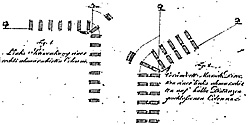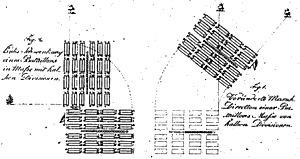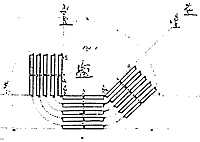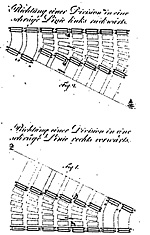Exercitium für die sämmentliche k.k. Infanterie, Generals-Reglement 1769 and Instructionspunkte für die gesammte Herren Generals der k.k. Armee 1794.
The Generals-Reglement 1769 apparently specified a 75 pace to the minute cadences, to which a 120 pace to the minute cadence was added under the Instructionspunkte 1794 for all evolutions. Unfortunately I have neither of the early Austrian documents but this seems to follow the trend seen elsewhere. As far as wheeling is concerned, Wagner, in his comparison of the Exercier-Reglement 1807 with the Generals-Reglement 1769 notes that the opening three principal parts of both are of similar length and contain instructions for the same basic manoeuvres and conversions. [29] It is here that the description of the moving pivot is found in the Exercier-Reglement 1807, but without sight of the earlier documents it is impossible to say whether the Austrians used the moving pivot or forming manoeuvre prior to 1806.
Abrichtungs-Reglement für die k. und k. k. Infanterie 1806 and Exercier-Reglement für die k.k. Infanterie 1807
The battalion consisted of six companies each of which formed a tactical sub-unit called a half-division, two of which formed a division. Each half-division consisted of two half-companies of two züge each. Under their later regulations the Austrians used the Ordinären Schritt of between 90 and 95 paces to the minute and the Doublirschritt of 120 paces to minute, the latter for all evolutions. They specify moving pivots for manoeuvring both columns and Massen and refer to them specifically as such, "beweglichen Pivots", throughout the relevant part of the Exercier-Reglement 1807. [30] The moving pivot in Austrian service must date from at least 1806, for the Exercier-Reglement 1807 refers to the method having been already established in the Abrichtungs-Reglement 1806 (Training Regulations 1806). [31] The Army Order of 15th March 1807 which accompanies the regulations makes it clear that the Abrichtungs-Reglement 1806 was the principal training tool for the soldier.
Forming was also in the Austrian repertoire and is described fully in the Abrichtungs-Reglement 1806. Basic Austrian wheeling and forming manoeuvres were described and illustrated in the article on the Austrian regulations in FE25.
Wheeling with a Moving Pivot - Schwenkung mit der Colonne (Wheeling with the Column) [32]
The column wheeled by means of the moving pivot established in the Abrichtungs-Reglement 1806. [33]
The cautionary command was
"Man wird sich rechts oder links schwenken!" ("Right or left wheel!")
"Rechts oder links schwenkt euch!" ("Right or left wheel dress!") on receipt of which heads were turned towards the wheeling flank to maintain dressing, followed by,
"Marsch!" when the wheel would be executed with the pivot, apparently, moving on a diagonal, followed by,
"Gerad aus!" ("straight on!") when the manoeuvre had been completed.
Wheeling a masse was conducted in similar fashion. The cautionary was, "Masse rechts oder links schwenkt euch", ("Mass right or left wheel dress"). The executive command "Marsch!" was delivered as before.
In this manoeuvre with a masse, however, the Exercier-Reglement 1807 points out specifically that the pivot moves on an arc. [34] The manoeuvre is exactly the same as the Prussian Schwenkungen während des Marches (Wheeling during the March).
"Gerad aus!" was given on completion of the movement.
The Austrian method of forming is similar to those found elsewhere and was described and illustrated in my article in FE25. The Exercier-Reglement 1807 is quite unambiguous that a division frontage was too wide to employ conventional wheels to change direction, and could only do so by means of forming, [36] which the Abrichtungs-Reglement 1806 shows could be executed to either flank, and to the rear.
Parallel deployment has been discussed at length in other articles in FE and it remained a necessary conversion for all nationalities. In general terms it was conducted more or less the same way. When a column of sub-units marched at deploying distance, it usually did so with its right in front. If deployment was necessary to the left, the sub-units simply wheeled up into the alignment on the left. If unit hierarchy was to be maintained, however, such a conversion to the right would place the right flank sub-unit on the left of the line and we saw in the section on France how a column of files overcame this problem.
Wheeling with a Stationary Pivot - Aufmarsch mit Abtheilungen hinter der Front (Deploying by Sub-units behind the Front). [37]
The cautionary command was, "Man wird hinter der ersten Abtheilung aufmarschiren!" ("Deploy behind the first Sub-unit").
When the head of the column reached the point where the line was to be formed, the executive command was given, "Rechts oder Links schwenkt euch! Gerad aus!" (Right or Left wheel! Straight ahead!). Each sub-unit behind the first, past to the rear of the latter and wheeled right falling in on its left.
On completion of each wheel, the command "Halt!" was given.
It could also be conducted using forming and this method had to be used when a column of divisions was involved. The command was, "Man wird hinter der ersten Abtheilung auflaufen!" ("Form behind the first Sub-unit").
The executive, delivered as above was, "Halt! Halb rechts oder halb links! Aufmarschirt!" "Marsch!" ("Halt! Half right or half left! Deploy!" "March!"), at which each division as it reached the appropriate place right inclined and right formed, falling in on the right flank division. On completion the command "Halt!" was given.
To close the section on Austria, a look at a more complex conversion.
Wheeling with a Moving Pivot - Front and Flügel verändern mit Abteilungen (Change of Front and Wing with Sub-units). [38]
Notice here that the half-division is the largest sub-unit on which this wheeling manoeuvre could be conducted. The cautionary command from the battalion commander was,
"Man wird auf der Mitte des Bataillons Front and Flügel verändern!" ("Change the Battalion's Front and Wing on the Centre!"). Followed by the executive, "Der rechte Flügel rechts um!" ("The right Wing about turn!" (to the rear)), upon receipt of which the individual soldiers in the right three half-divisions each executed an about turn to the right. The battalion now stood with the right wing retired and the left advanced. There then followed the command "Marsch!", and "Halt!" after nine paces, which staggered the two wings.
The next command was a further cautionary, "Beide Flügel mit zügen, halben Compagnien, halben Divisions rechts schwenkt euch!" ("Both wings by zügen, half companies, half divisions right wheel dress!"), and "Marsch!".
The complete wheel was then carried out. The first sub-unit of the left wing was given the order
"Rechts schwenkt euch!" "Marsch!" (Right wheel dress! March!) followed by "Halt!" eight paces short of the new alignment by its officer commanding who dressed it, and then directed it onto it by, "Marsch!" and "Halt!".
At this point the battalion was on the new alignment but with the left wing advanced and the right wing still retired.
It was now only necessary to give the latter the command "Front!" ("About turn!" (to the front)) and the change of front and wing was complete.
The conversion is shown above.
Wheel Continued
Back to Table of Contents -- First Empire #28 This article appears in MagWeb (Magazine Web) on the Internet World Wide Web. Wheels in columns at deploying and half deploying are shown at left.
Wheels in columns at deploying and half deploying are shown at left.
 Changing the direction of march and wheeling en masse are at Fig 1 and 2 respectively at right,
A method used by the French to change the direction of a colonne serrée en masse, which require a wheeling flank march of files is shown, at right, for comparison. [35]
Changing the direction of march and wheeling en masse are at Fig 1 and 2 respectively at right,
A method used by the French to change the direction of a colonne serrée en masse, which require a wheeling flank march of files is shown, at right, for comparison. [35]
 It also follows, therefore, that any unit unable to form would also be unable to wheel when deployed with a frontage larger than that of a half division. This is true, but an individual division would be able to change direction in some circumstances through moving by its constituent sub-units. A division changing position, as it might in a linear echelon type manoeuvre by a battalion, is shown at left.
It also follows, therefore, that any unit unable to form would also be unable to wheel when deployed with a frontage larger than that of a half division. This is true, but an individual division would be able to change direction in some circumstances through moving by its constituent sub-units. A division changing position, as it might in a linear echelon type manoeuvre by a battalion, is shown at left.
 This manoeuvre was clearly also intended for a deployment when the head of the column was formed with the left in front. The conversion is shown at right.
This manoeuvre was clearly also intended for a deployment when the head of the column was formed with the left in front. The conversion is shown at right.
 The command, "Aufmarschirt!" ("Deploy!") followed, upon which the remaining sub-units of the left wing wheeled into line on the left of the first sub-unit. The sub-units of the right wing meanwhile executed their wheel towards the new alignment, which when parallel with were ordered, "Gerad aus!" (Straight ahead!"), and "Halt!" when they arrived on it.
The command, "Aufmarschirt!" ("Deploy!") followed, upon which the remaining sub-units of the left wing wheeled into line on the left of the first sub-unit. The sub-units of the right wing meanwhile executed their wheel towards the new alignment, which when parallel with were ordered, "Gerad aus!" (Straight ahead!"), and "Halt!" when they arrived on it.
Introduction
Life Before Cadence
Wheeling With a Stationary Pivot
Wheeling With a Moving Pivot
The Regulations: France
The Regulations: Prussia
The Regulations: Austria
The Regulations: Britain and KGL
Summary and Conclusions
Footnotes
[29] Wagner, Walter. Von Austerlitz bis Königgrätz, Österreich Kampftaktik im Spiegel der Reglements 1805-1864. pp7-11.
[30] Exerzier-Reglement für die Kaiserlich--Königliche Infanterie 1807. Wien, 1807. pp79-87.
[31] Ibid. p79.
[32] Ibid. p78.
[33] Abrichtungs-Reglement für die k. und k. k. Infanterie 1806. Wien, 1806. pp107-115. See also my article in FE 25.
[34] Exerzier-Reglement 1807. op. cit. p82.
[35] Règlement 1791. op. cit. Ecole de Bataillon, Planche XV and p39.
[36] Exercier-Reglement 1807. op.cit. p85.
[37] Ibid. pp87-89.
[38] Ibid. pp104-105.
Back to Table of Contents -- First Empire #29
© Copyright 1996 by First Empire.
Other military history articles and gaming articles are available at http://www.magweb.com